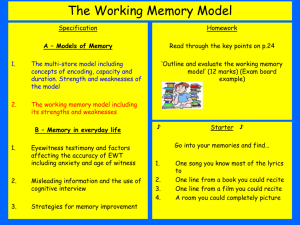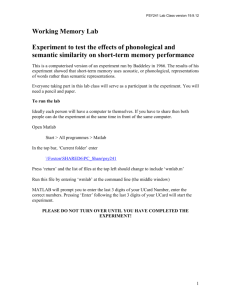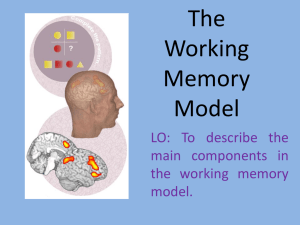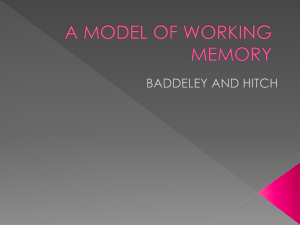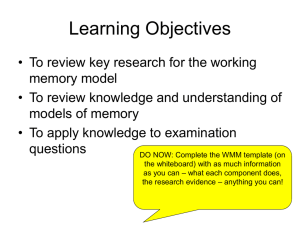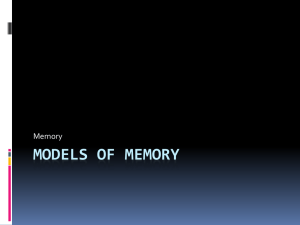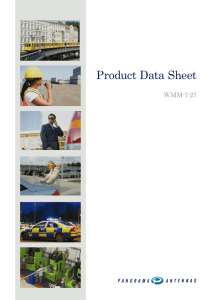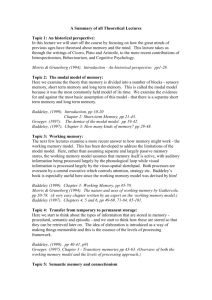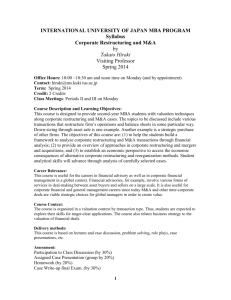Lesson 3 (Working Memory Model)
advertisement
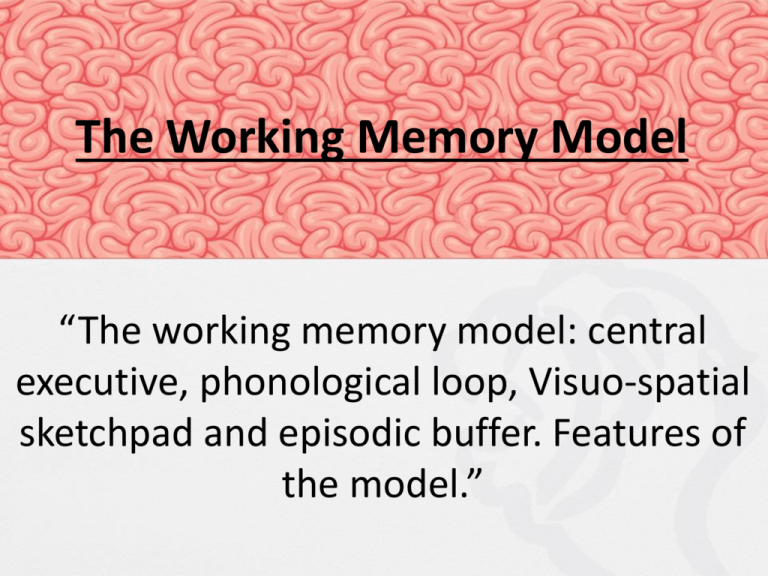
The Working Memory Model “The working memory model: central executive, phonological loop, Visuo-spatial sketchpad and episodic buffer. Features of the model.” The Working Memory Model AO1 State the functions of each of the four stores of the WMM AO2 Apply knowledge of the WMM to results from a Dual-Tasks AO3 Evaluate the Working Memory Model using case studies, clinical evidence and studies of dual-task performance. Working Memory Model Components of working memory Central Executive: Directs attention to particular tasks. It controls the other systems by determining how resources will be allocated. (Think a control tower at an airport.) Phonological loop: Controls auditory information. Further subdivided into the phonological store (inner ear) and articulatory process (inner voice). Visuo-spatial pad: Processes visual and spatial information (how things look and where they are). Episodic buffer: General store. Added later to the model to account for things that use both visual and acoustic information. • We saw with the multi-store model that a representation is drawn. • We will now look at the working memory model…whilst exercising your memories! – In groups of 4 – A3 paper each – Each take turn at looking at the model for 30 seconds then report back to group. Group must try and draw model from reports – reporter CANNOT draw! The Working Memory Model (Baddeley & Hitch, 1974) • Key component in model • Functions: –Direct attention to tasks – Determine how resources (slave systems) are allocated. • Limited Capacity • Limited Capacity • Deals with auditory information and preserves word order • Baddeley (1986) further subdivided it into – Phonological store ( holds words heard) – Articulatory process ( holds words heard/seen and silently repeated ( looped) like an inner voice. • Visual and/or spatial information stored here – Visual = what things look like – Spatial = relationships between things • Limited capacity • Logie (1995) suggested subdivision: – Visuo-cache (store) – Inner scribe for spatial relations. • Baddeley ( 2000) added episodic buffer as he realised model needed a more general store. • Slave systems deal with specific types of information. • Central executive has no storage capacity • Buffer extra storage system but with limited capacity. • Integrates information from all other areas. • We’ve seen the model now lets talk about the model..... – Write ONE question about the working memory model (that you know the answer to). – You will go and test the class and see how well they have understood/remembered the model. • To test the idea of more than one component, Baddeley and Hitch devised the dual task technique. • Let’s see what happened….. Your turn! • You will now complete a dual task technique ( one that was used by Baddeley and Hitch). • Repeat the numbers below aloud whilst ticking the true/false answers 482917 • • • • • • • • • • 1: 2: 3: 4: 5: 6: 7: 8: 9: 10: B is followed by A A is preceded by B A is not followed by B B follows A B does not follow A B is not followed by A A follows B B is not preceded by A A is not followed by B B does not precede A BA AB BA AB BA AB AB AB BA AB True/False True/False True/False True/False True/False True/False True/False True/False True/False True/False Their research (Baddeley & Hitch)….. • Asked participants to perform a reasoning task whilst simultaneously reciting aloud a list of 6 digits. • If digit span is really a measure of STM capacity, participants would be expected to show impaired performance on the reasoning task because their STM would be fully occupied. • However, found participants made few errors on either, though the speed was slightly slower. Summarise 1) What did they do in the experiment (HINT: it’s what you did!!) 2) How does this support evidence for the working memory model? • Baddeley (1996) investigated selective attention and switching retrieval plans. Asked participants to generate random strings of digits on a keyboard (this is quite hard as you have to pay close attention in order to avoid some kind of pattern emerging). • This was carried out: a) b) c) d) Alone (control) Alongside another task such as reciting the alphabet - Condition 1 Counting from one – Condition 2 Alternating between letters and numbers (A1, B2, C3) – Condition 3. • The generated digit string became increasingly less random in Condition 3 where participants had to switch from alphabet to numbers at the same time. • Baddeley concluded that both the random number generation task and the alternation task were competing for the same central executive resources. • Remember the following: • Harm • Twice • Calm • Share • Tree • Book • Sun • Four • Key • Short Recall them! • How many did you get right? • Harm • Twice • Calm • Share • Tree • Book • Sun • Four • Key • Short And again..recall these: • Association • Representative • Discouragement • Meaningfulness • Suppression • Enhancing • Component • Performances • Forgetting • Damaging Recall them! • How many did you get right? • Association • Representative • Discouragement • Meaningfulness • Suppression • Enhancing • Component • Performances • Forgetting • Damaging • It seems that the phonological loop holds the amount of information that you can say in 1.5 - 2 seconds (Baddeley et al, 1975). • This makes it hard to remember a list of long words such as ‘association’ and ‘representative’ compared to shorter words like ‘harm’ and ‘twice’ and therefore inhibits rehearsal of longer words! • Word length effect disappears if a person is given an articulatory suppression task (‘the, the, the’ while reading the words). • The repetitive task ties up the articulatory process and means you can’t rehearse the shorter words more quickly than the longer ones, so the word length effect disappears. • Baddeley et al (1975) demonstrated the existence of the visuospatial sketchpad. • Participants were given a visual tracing task (they had to track a moving light with a pointer). At the same time they were given one of two other tasks; a) b) Task 1 was to describe all the angles on the letter F. Task 2 was to perform a verbal task. • Task 1 was very difficult, but not task 2, presumably because the second task involved two different components (or slave systems). • This is also evidence related to the effects of doing two tasks using the same or different components. This was a highly controlled laboratory experiment using a repeated measures design to eliminate individual differences. However, the task was rather artificial. • Baddeley et al (1987) – PPTs were shown words and then immediate recall – Recall was much better for sentences (related words) than unrelated • Supports idea of ‘general’ memory store that draws on LTM (semantics) • Case of KF (Shallice and Warrington, 1970) showed that STM works independently of LTM. • STM forgetting of auditory information was much greater than that of visual stimuli. Thus his brain damage seemed to be restricted to the phonological loop. – Letters – Meaningful sounds…ring ring • LH - had been involved in a road accident. Performed better on spatial tasks than those involving visual imagery (Farah et al, 1988). This suggests separate visual and spatial systems. Working Memory Model or Multi-Store Model? Which is better? Why? Pass the ReactaBall around the classroom. When it gets to you a word will appear on the board. You need to contribute as follows: What is an evaluation point of the WMM? What is a piece of evidence we can use to evaluate the WMM? So What? What does this mean for the WMM Model? Elaborate on the previous point. What does the research evidence suggest? However… How can we contradict this point? Give an alternative contrasting evaluation point of the WMM. Or give an alternative contrasting piece of evidence. . What is an evaluation point of the WMM? What is a piece of evidence we can use to evaluate the WMM? . So What? What does this mean for the WMM Model? Elaborate on the previous point. What does the research evidence suggest? . However… How can we contradict this point? Give an alternative contrasting evaluation point of the WMM. Or give an alternative contrasting piece of evidence. . So What? What does this mean for the WMM Model? Elaborate on the previous point. What does the research evidence suggest? . However… How can we contradict this point? Give an alternative contrasting evaluation point of the WMM. Or give an alternative contrasting piece of evidence. . So What? What does this mean for the WMM Model? Elaborate on the previous point. What does the research evidence suggest? . However… How can we contradict this point? Give an alternative contrasting evaluation point of the WMM. Or give an alternative contrasting piece of evidence. . So What? What does this mean for the WMM Model? Elaborate on the previous point. What does the research evidence suggest? 1) How does the WMM compare the MSM? 2) How reliable is the evidence for the WMM? What methods have been used? 3) How can the WMM be useful in real life? Does it have any real life applications? 4) How comprehensive is the WMM in explaining memory? Use your textbook to create a revision page for ‘explanations of forgetting’. Make sure to include AO1 (Knowledge) and AO3 (Evaluation) You will be tested on this knowledge next week

